2003 Oldsmobile Alero ECU
[x] Cancel search: ECUPage 6 of 354

These are some examples of vehicle symbols you may find on your vehicle:
POSSIBLE A
CAUTION
INJURY
PROTECT EYES BY
SHIELDING
CAUSTIC
BATTERY
ACID COULD CAUSE
BURNS
AVO1 D
1 SPARKS OR
1 FLAMES
1 BATTERY LATCH BOTH LAP AND
SHOULDER BELTS TO
PROTECT OCCUPANT
48: @
DO NOT TWIST SAFETY
BELT WHEN ATTACHING
FASTEN SEAT
BELTS
MOVE SEAT FULLY
\!$
REARWARD+ /z
SECURE
CHILD SEAT
PULL BELT
COMPLETELY
THEN SECURE CHILD SEAT
I
1
DO NOT INSTALL
A REAR-FACING
CHILD RESTRAINT IN THIS SEATING
POSITION
DO NOT INSTALL A
'ORWARD-FACING CHILD RESTRAINT
IN THIS SEATING
POSITION
--,.-. ,.,.,, a uvun Luun
UNLOCK JGHTING
- MASTER SWITCH B- / ,
SIGNALS @+
TURN
PARKING
pf
LAMPS
DAYTIME
**a
RUNNING y.:
LAMPS 0
ENGINE
COOLANT TEMP
CHARGING
I-]
BATTERY SYSTEM
COOLANT
d
ENGINE OIL
PRESSURE
Wb
ENGINE
COOLANT FAN
OWNERS MANUAL
SERVICE
SFRVICF
MANUAL
V
Page 8 of 354
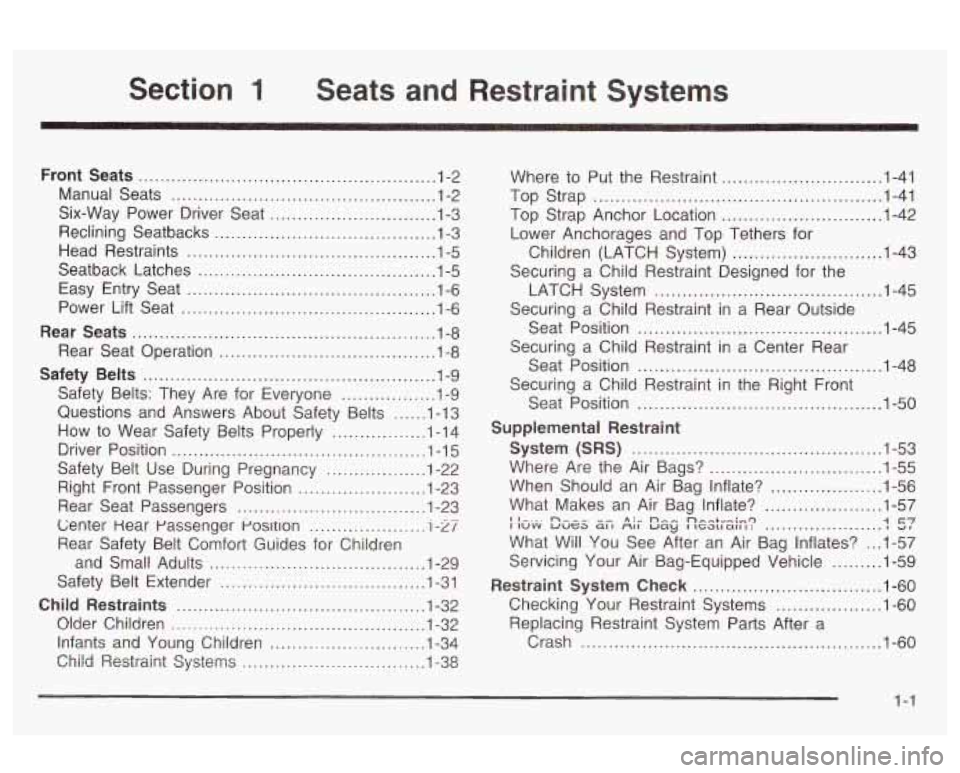
Section 1 Seats and Restraint Systems
Front Seats .......................... ...... 1-2
Manual Seats
............................... ...... 1-2
Six-Way Power Driver Seat
............. , ......... 1-3
Reclining Seatbacks
........................................ 1-3
Head Restraints
............................................. 1-5
Seatback Latches ........................................... 1-5
Easy Entry Seat
............................................. 1-6
Power Lift Seat
.............................................. 1-6
Rear Seats
...................................................... .l -8
Rear Seat Operation ....... ........................ -1 -8
Safety Belts
..................................................... 1-9
Safety Belts: They Are for Everyone
................. 1-9
Questions and Answers About Safety Belts
...... 1-13
How to Wear Safety Belts Properly
................. 1-14
Driver Position
.............................................. 1-1 5
Safety Belt Use During Pregnancy .................. 1-22
Right Front Passenger Position
....................... 1-23
Rear Seat Passengers
.................................. 1-23
Lenter Hear passenger Posltion
i -z
Rear Safety Belt Comfort Guides for Children
_I .....................
and Small Adults ....................................... 1-29
Safety Belt Extender
..................................... 1-31
Child Restraints
............................................. 1-32
OIder Children .............................................. 1-32
Infants and Young Children
............................ 1-34
Child Restraint Systems
................................. 1-38 Where
to Put the Restraint
........ ...... 1-41
Top Strap
................................................ -1 -41
Top Strap Anchor Location
............................. 1-42
Children (LATCH System)
........................... 1-43
Lower Anchorages
and Top Tethers for
Securing a Child Restraint Designed for the
Securing
a Child Restraint in a Rear Outside
Securing a Child Restraint in a Center Rear
Securing a Child Restraint in the Right Front
LATCH System
......................................... 1-45
Seat Position
............................................ 1-45
Seat Position
............................................ 1-48
Seat Position
......................................... 1-50
Supplemental Restraint System (SRS)
............................................. 1-53
Where Are the Air Bags?
............................... 1-55
When Should an Air Bag Inflate?
.................... 1-56
What Makes an Air Bag Inflate?
..................... 1-57
What Will You See After an Air Bag Inflates?
... 1-57
Servicing Your Air Bag-Equipped Vehicle
......... 1-59
I I - ... n--- -- n., ne- n-e4v-:-q I IUVV uut;a a1 I r\ll uay 1ca11all I : ..................... 157
Restraint System Check .................................. 1-60
Checking Your Restraint Systems ................... 1-60
Replacing Restraint System Parts After
a
Crash ...................................................... 1 -60
1-1
Page 15 of 354
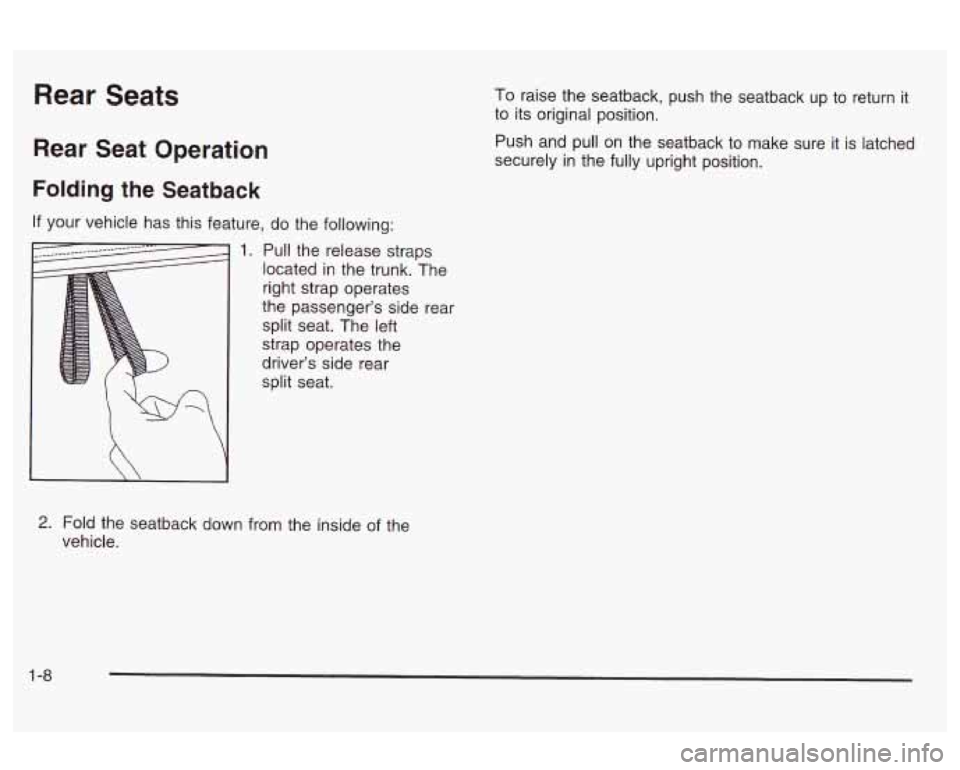
Rear Seats
Rear Seat Operation
Folding the Seatback
If your vehicle has this feature, do the following:
1. Pull the release straps
located in the trunk. The
right strap operates
the passenger’s side rear
split seat. The left
strap operates the
driver’s side rear
split seat. To
raise the seatback, push the seatback up to return it
to its original position.
Push and pull on the seatback to make sure it is latched
securely
in the fully upright position.
2. Fold the seatback down from the inside of the
vehicle.
1-8
Page 23 of 354
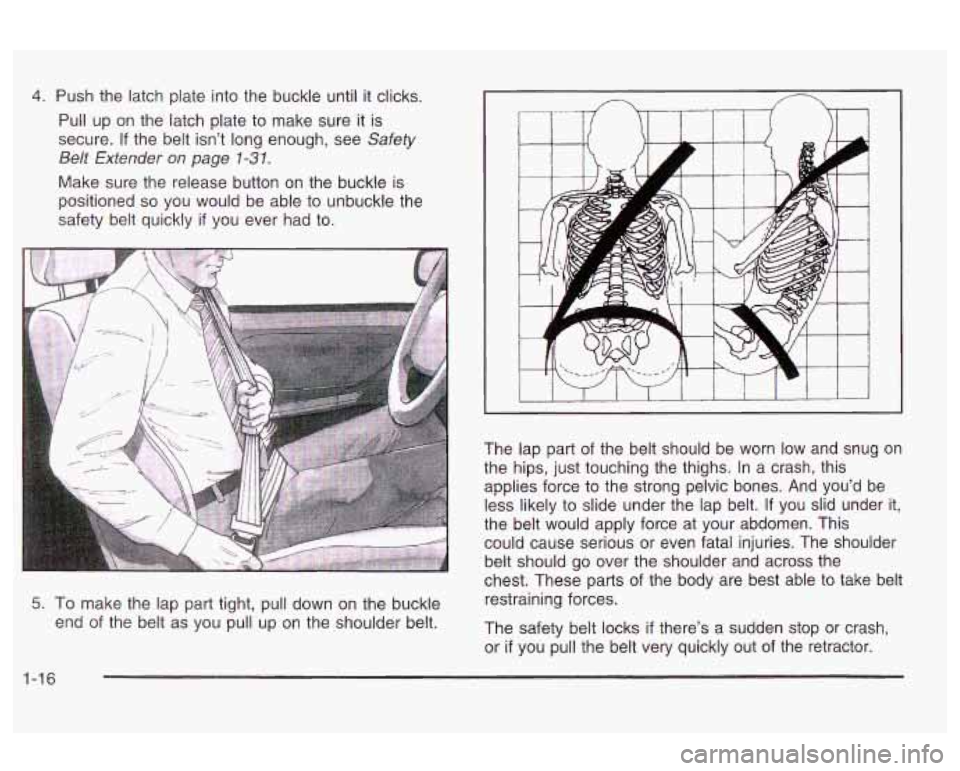
4. Push the latch plate into the buckle until it clicks.
Pull up on the latch plate to make sure it is
secure.
If the belt isn’t long enough, see Safety
Belt Extender
on page 1-3 1.
Make sure the release button on the buckle is
positioned
so you would be able to unbuckle the
safety belt quickly
if you ever had to.
5. To make the lap part tight, pull down on the buckle
end of the belt as you pull up on the shoulder belt.
I I--
The lap part of the belt should be worn low and snug on
the hips, just touching the thighs. In a crash, this
applies force to the strong pelvic bones. And you’d be
less likely to slide under the lap belt.
If you slid under it.
the belt would apply force at your abdomen. This
could cause serious or even fatal injuries. The shoulder
belt should go over the shoulder and across the
chest. These parts of the body are best able to take belt
restraining forces.
The safety belt locks if there’s a sudden stop or crash,
or
if you pull the belt very quickly out of the retractor.
1-16
Page 31 of 354

Lap-Shoulder Belt
The positions next to the windows have lap-shoulder
belts. Here’s how to wear one properly.
2. Push the latch plate into the buckle until it clicks.
1. Pick up the latch plate and pull the belt across you.
Don’t let
it get twisted.
The shoulder belt may lock
if you pull the belt
across you very quickly.
If this happens, let the belt
go back slightly to unlock it. Then pull the belt
across you more slowly. If
the belt stops before
it reaches the buckle, tilt the
latch plate and keep pulling until you can buckle it.
Pull up on the latch plate to make sure it is secure.
If the belt is not long enough, see
Safety Belt
Extender on page
7-37. Make sure the release
button on the buckle is positioned
so you would be
able to unbuckle the safety belt quickly
if you
ever had to.
1-24
Page 42 of 354
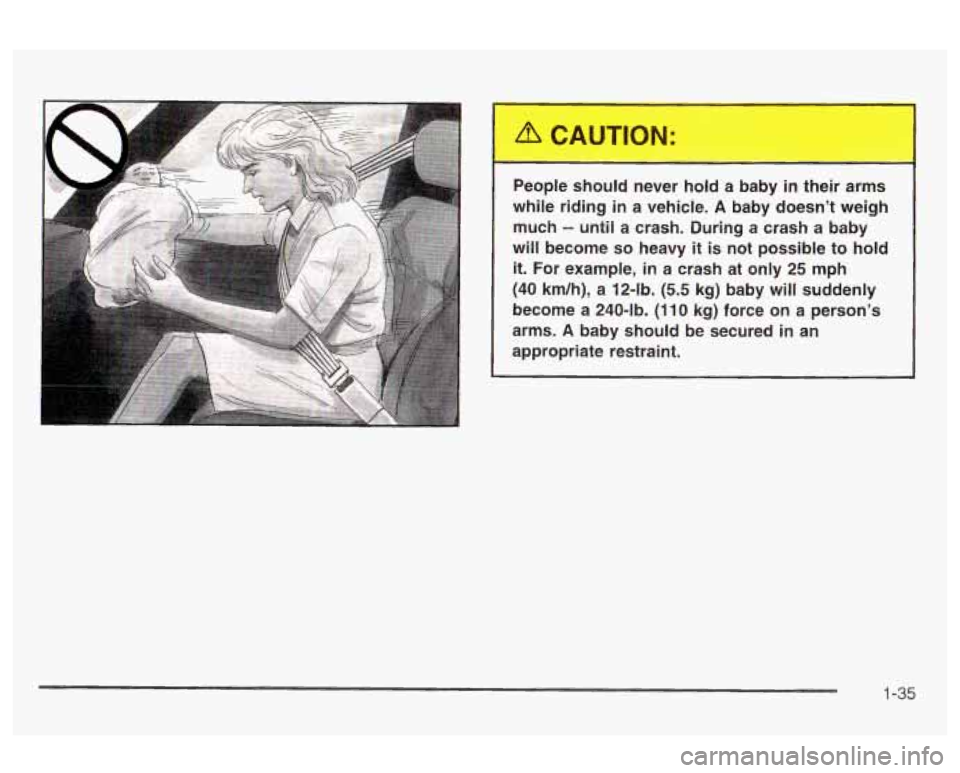
People should never hold a baby in their arms
while riding in a vehicle.
A baby doesn’t weigh
much
-- until a crash. During a crash a baby
will become
so heavy it is not possible to hold
it. For example, in a crash at only 25 mph
(40 km/h), a 12-lb.
(5.5 kg) baby will suddenly
become a 240-lb. (1 10 kg) force on a person’s
arms.
A baby should be secured in an
appropriate restraint.
1-35
Page 44 of 354

The restraint manufacturer’s instructions that come
with the restraint, state the weight and height
limitations for a particular child restraint. In addition,
there are many kinds of restraints available for
with special -eeds.
Newborn infants need complete support,
including support for the head and neck. This
is necessary because a newborn infant’s neck
is weak and its head weighs
so much
compared with the rest of
its body. In a crash,
an infant in a rear-facing seat settles into the
restraint,
so the crash forces can be
distributed across the strongest part of an
infant’s body, the back and shoulders. Infants
always should be secured in appropriate infant
restraints.
J
The body StrL,,,.? 0. - young child is quite
unlike that of an adult or older child, for whom
the safety belts are designed.
A young child’s
hip bones are still
so small that the vehicle’s
regular safety belt may not remain low on the
hip bones, as
it should. Instead, it may settle
up around the child’s abdomen. In a crash, the
belt would apply force on a body area that’s
unprotected by any bony structure. This alone
could cause serious or fatal injuries. Young
children always should be secured in
appropriate child restraints.
1-37
Page 47 of 354
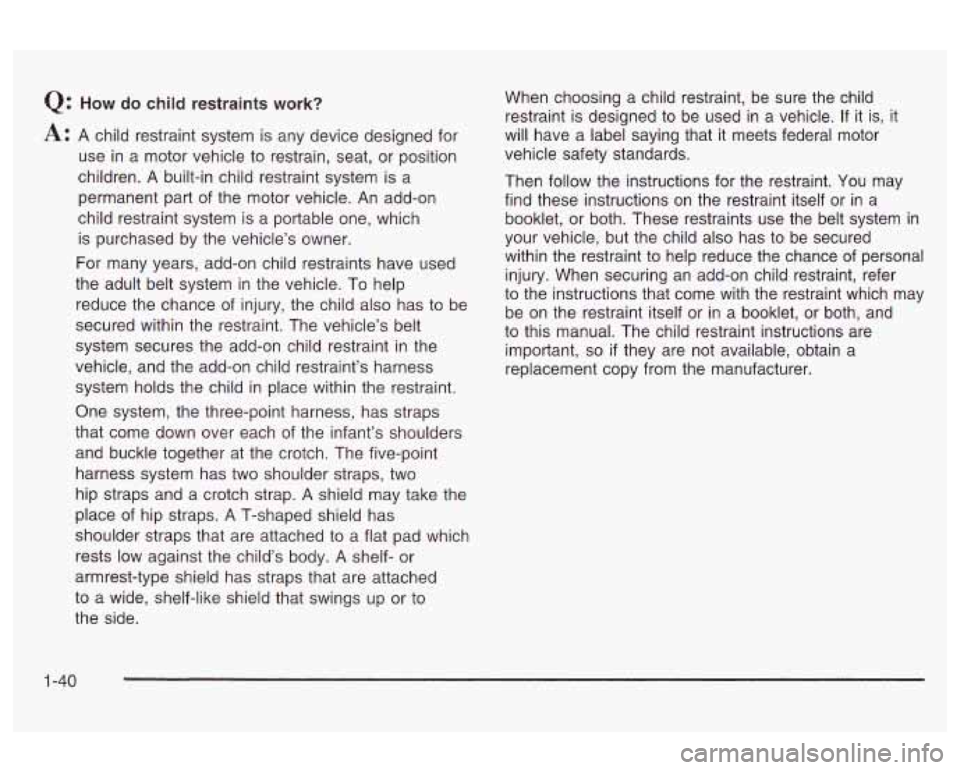
Q: How do child restraints work?
A: A child restraint system is any device designed for
use in a motor vehicle to restrain, seat, or position
children. A built-in child restraint system is a
permanent part of the motor vehicle. An add-on
child restraint system is a portable one, which
is purchased by the vehicle’s owner.
For many years, add-on child restraints have used
the adult belt system in the vehicle. To help
reduce the chance of injury, the child also has to be
secured within the restraint. The vehicle’s belt
system secures the add-on child restraint in the
vehicle, and the add-on child restraint’s harness
system holds the child in place within the restraint.
One system, the three-point harness, has straps
that come down over each
of the infant’s shoulders
and buckle together at the crotch. The five-point
harness system has two shoulder straps, two
hip straps and a crotch strap.
A shield may take the
place
of hip straps. A T-shaped shield has
shoulder straps that are attached to a flat pad which
rests low against the child’s body.
A shelf- or
armrest-type shield has straps that are attached
to a wide, shelf-like shield that swings up or to
the side. When choosing a
child restraint, be sure the child
restraint is designed to be used in a vehicle.
If it is, it
will have a label saying that it meets federal motor
vehicle safety standards.
Then follow the instructions for the restraint. You may
find these instructions on the restraint itself or in a
booklet, or both. These restraints use the belt system in
your vehicle, but the child also has
to be secured
within the restraint to help reduce the chance of personal
injury. When securing an add-on child restraint, refer
to the instructions that come with the restraint which may
be on the restraint itself or in a booklet, or both, and
to this manual. The child restraint instructions are
important,
so if they are not available, obtain a
replacement copy from the manufacturer.
1-40